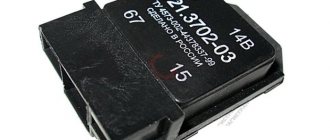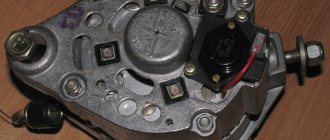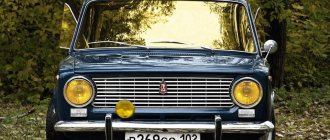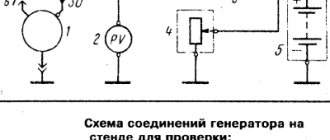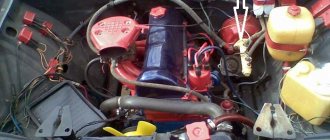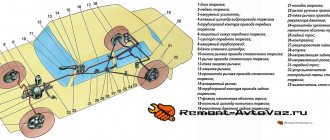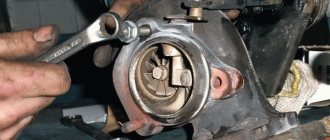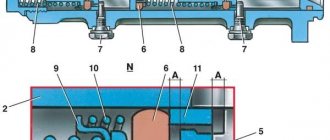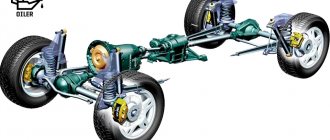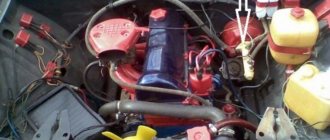Purpose of the overrunning clutch
The main problems of machine V-belt transmissions are traditionally:
- the crankshaft does not have a constant rotation speed, it rotates jerkily according to the fuel ignition cycles
- secondary shafts receiving rotation from the crankshaft have inertia, so they either lag or advance the generator pulley
- one belt is used for several units, which increases the moment of inertia, slipping of the belt occurs during moments of impulse transmission of rotation from the crankshaft
- the car moves unevenly with braking and acceleration, the engine periodically stops and starts up
Such an abundance of jerking and weakening inevitably leads to intense wear of the V-belt drive. The tensioner rollers suffer, the pulleys wear out, and the vehicle downtime for repairs increases.
To solve these problems, a generator overrunning clutch was created, consisting of two interconnected cages. The outer one dampens the inertia of the armature shaft, the inner one is a locking device similar to the starter bendix.
Rice. 2 Operating principle of the overrunning clutch
The best example of synchronizing rotation using a freewheel is a bicycle. When untwisting the pedals, an analogue of this device ensures rigid coupling of the pedals with the rear shaft. During free rolling, the shaft continues to rotate and the pedals are disengaged so that the user can rest their feet on them.
Where was it first installed?
The diesel versions had the shortest belt drive life (no more than 15,000 km), they have a higher rate of pressure rise (more torque ), as well as greater braking of the crankshaft during compression, something had to be done, it was these units that acquired overrunning components for the first time , which have proven themselves to be excellent.
Then there were executive class cars, namely large, large engines, with a lot of electronics in the cabin. The generators had to be more massive, the anchors were heavier, and the inertia was greater.
Today we see such couplings on almost all cars, as they say, from “small to large.” This is truly a very useful unit!
Advantages and disadvantages
Many manufacturers install an alternator overrunning clutch at the factory. In this case, the owner does not need to improve anything, but the resource of this unit should be taken into account for timely replacement. Every car enthusiast can visually distinguish the equipment of a generator:
- a regular pulley is always secured to the shaft with a nut
- The clutch cannot have a freewheel nut; most often its end is covered with a protective cover
Rice. 3 On the left is a regular pulley, on the right is an overrunning clutch
Since ideal designs do not exist in principle, an overrunning clutch, in comparison with a conventional pulley, also has pros and cons, discussed below.
Price
An overrunning clutch costs 1500 - 8000 rubles, which is much more expensive than a regular pulley (200 - 500 rubles). When replacing this “consumable” with your own hands, you will need a special head at a price of 200 - 500 rubles instead of the usual hexagonal equipment, which is usually found in every car enthusiast’s kit.
Resource
Since repair of the moving parts of the generator is necessary, both when operating a conventional pulley and when using an overrunning clutch, the service life of the entire set of kinematic diagrams of the V-belt drive should be taken into account:
- the pulley is ordinary - the grooves wear out and become unusable after about 200,000 km
- overrunning clutch - according to the manufacturer's requirements, replacement is required every 100,000 km
- belt - depending on the specific brand, car model and kinematic diagram, changes after 25 - 50 thousand mileage
Rice. 4 Regular alternator pulley
Rice. 5 Overrunning clutch
Rice. 6 Alternator belt
In other words, if under the hood of a car the generator is driven from the crankshaft by an individual belt, then it is more profitable to use a regular pulley. In the case of driving several consumers with one belt (furnace, air conditioning compressor, etc.), it is advisable to install an overrunning clutch on the generator, if the manufacturer has not already done this on the conveyor.
Maintainability
For both the regular pulley and the overrunning clutch, repairs are not economically profitable. Therefore, these consumables are changed entirely, but for different reasons:
- the pulley is relatively cheap, there is no point in handicraft soldering and grinding the “grooves” for the belt seats - this will cost more than a new part manufactured industrially
- Repairing the overrunning clutch is too complicated, which will also cost more than the cost of the part on store shelves
The belt is changed more often, but always as a whole; its maintainability is zero by default.
Attention: Service station specialists note freezing of the coupling race lubricant during operation in cold regions of the Russian Federation. With ordinary pulleys this problem does not exist in principle.
Common faults
The design of the generator coupling is somewhat similar to a rolling bearing, so if a malfunction occurs it can jam. This leads to the fact that the belt drive begins to wear out at an accelerated rate, since the moments of inertia are no longer compensated. Ultimately, the alternator belt will break and the tensioner will wear out - all these parts will have to be replaced.
To detect clutch malfunctions in a timely manner, you need to know their “symptoms”. The most characteristic signs are the following:
- rattling appears in the cabin (an experienced driver will not be able to confuse it with anything);
- when driving slowly, the car begins to vibrate;
- the belt begins to bounce;
- when the engine is turned on, a characteristic whistle is heard;
- The tensioner starts clicking.
If at least one of these signs appears, you should immediately contact a service station. The technician will have to diagnose the entire unit. If during diagnostic procedures it is revealed that the coupling is faulty, it will have to be replaced - such units cannot be repaired.
There is another typical malfunction, although it is less common - the clutch begins to spin in all directions. In this case, when rotating, the anchor is not connected to the holder in any way. It is more difficult to diagnose such a malfunction - you will definitely have to remove the generator. The probable cause is an undercharged battery.
Types of breakdowns and their causes
Typically, the overrunning clutch fails under the following circumstances:
- pulley malfunction;
- wear of the inner spring;
- the alternator belt is broken;
- mileage more than 100 thousand km;
- overrunning mechanism malfunction.
Failure rates
Signs of a malfunctioning alternator overrunning clutch:
- during operation, unnatural noises are heard from the generator;
- complete stoppage of generator operation;
- When the air conditioner is running or when the machine is moving slowly, a noticeable vibration occurs;
- belt whistle at high speeds;
- short crackling sound when starting or stopping the engine.
Defect detection
To diagnose the operation of the unit, you should spin the engine to 4 thousand revolutions. Then you need to turn on the ignition. You need to listen to the residual sound. If it resembles the sound of a turbine stopping, then the generator clutch is working properly. If there is none, then the mechanism requires replacement.
The coupling can also be checked in a dismantled state; to do this, do the following:
- pinch the inner ring with your fingers;
- turn the outer ring in the direction of belt rotation;
- When the outer race moves, the coupling fails and needs to be replaced.
You can do the same experiment. But it is necessary to rotate the outer race in the opposite direction. In this case, on the contrary, it should rotate. If this does not happen, then the part has failed.
Visual and auditory diagnostics without dismantling
- We turn on the engine in idle mode - when the belt tensioner is actively moving, the clutch is faulty.
- We accelerate the engine to 2 thousand revolutions and turn it off. A buzzing or whistling sound is a sign of faulty mechanism bearings. A cracking sound is evidence of clutch wear.
Methods for diagnosing a dismantled coupling
After visual diagnostic methods have shown the presence of a malfunction, we dismantle the coupling
.
Upon closer inspection, you need to lock the inner race, and rotate the outer ring in the direction of its natural movement when working in the system or in the opposite direction. If the inner race moves, the clutch is worn out.
If the outer ring does not rotate in the direction opposite to the movement of the alternator belt, the pulley is faulty. Overrunning and reversing mechanisms of free movement should spring when checked if the outer ring is set to the direction of direct rotation of the drive, and rotate freely in the opposite direction. If the coupling is not moving properly, it must be replaced.
Overrunning clutch design
Unlike the classic generator pulley, the operating principle of the overrunning clutch is much more complicated:
- the inner race is pressed onto the generator shaft
- the outer race is motionless relative to the pulley
- the rollers are located between the clips in several rows
- when the generator armature is accelerated by the crankshaft, the rollers move upward due to centrifugal force, the engagement becomes rigid, these shafts rotate at the same speed
- at the moment of compression of the fuel mixture in the cylinders there is no ignition, the crankshaft begins to lag in rotation relative to the generator shaft that has gained inertia due to the mass of the armature
- the inner race begins to overtake the outer one, the rollers fall down, the clutch of the assembly is disconnected
Rice. 7 Overrunning clutch design
After the next ignition of a portion of the fuel mixture in the combustion chambers, the cycle is repeated many times.
Thus, the shaft (armature) and the generator pulley rotate independently of each other at different times. There is no inertia on the generator belt, this consumable lasts longer.
Ratchet and friction rotation synchronization devices are divided into several types:
- radially closed
- with axial locking
- tape modifications
- couplings with spring mechanisms
- wedge overrunning clutches
In passenger cars, wedge overrunning clutches are more often used due to their simple design and low manufacturing cost. In addition to two rows of rollers and a pair of clips, the design includes the following parts:
- splined profile for installation and removal of the coupling
- elastic gasket
- polymer cover
- contact plate into which the oil seal is mounted
Without a cover, operating the rotation synchronization device is strictly prohibited.
Reasons for trouble-free shaft rotation
If the shaft rotates without problems, the possible cause is a broken coupling. Consequence: The generator will not charge, it will generate heat, which will cause thermal damage, discoloration of the metal.
Important reasons:
- incorrect part not intended for use (high torsional vibration);
- the shield was not used (loss of lubrication, heat generation);
- problem with the clutch.
The problem can be identified by the following signs:
- the grease is black and has lost its properties,
- there are deep pits on the protrusions of the outer ring,
- all pulley needles were damaged,
- the inner ring is damaged (dents on the raceway),
- corrosion on the inner and outer rings.
If the shaft does not rotate in any direction, a broken spring or bushing may be the cause. Main reason: the spare part is not intended for use; There are strong torsional vibrations in the cylinder.
Overrunning clutch failures
Having understood why a coupling on the generator shaft is needed, it is necessary to take into account the nuances of operating this consumable part:
- breakdowns are usually caused by wear of the clips and their jamming relative to each other
- The frequency of replacement is indicated by the manufacturer on the packaging; on average, it is 100,000 km of vehicle mileage.
Once the races are jammed, the overrunning clutch actually becomes an ordinary pulley. But in some cases (rollers spilling out), the adhesion of the pulley to the generator armature completely disappears, and the generation of electricity stops. In the latter case, the car will travel a short distance until the entire battery charge is used up.
In the bottom photo, the right clutch has exhausted its service life and was used correctly. The left part rusted without a protective cover and jammed, as evidenced by the shiny surface of the pulley grooves. In the sample center there is a new coupling with no real service life.
Rice. 8 Comparison of new and two used couplings
Removing the inertia pulley of the Toyota Avensis generator
On a Toyota Avensis with a 1AD-FTV diesel engine, to remove the clutch you also have to remove the entire generator, which is located in the right corner of the engine compartment, below, closer to the front passenger. In addition, here, in order to get to the desired unit, you have to jack up the car and unscrew the right wheel.
Unscrewing the generator mount is generally not difficult; the whole problem is how to remove this device. The overrunning pulley itself is removed as standard with a special key, and in this case it is also better to halve the body, and to unscrew the OMG, use a hexagon, holding the armature in a vice.
You need to carefully and carefully separate the parts of the generator housing; in a hurry, you can break the stator winding and break the wires.
DIY replacement
To ensure the service life declared by the manufacturer, the overrunning clutch is equipped with a protective cover. If the owner/service employee forgot to install it or it falls off during use, dirt/dust penetrating into the clips may jam the rollers.
A replacement is available for self-repair of this generator unit, but with special equipment, since ordinary hex heads are not suitable for this.
Tool
A special head will help you unscrew a jammed overrunning clutch. The asking price is 170 – 500 rubles, there are several options for equipment:
- with teeth at the end in the middle part and a 1/2" connecting square for VW, Skoda, Mercedes, Ford, BMW, Audi and some other cars
- hexagon 17 and connecting head 10 for Toyota and some other Asian and hexagon for the generator coupling of VAG cars
Service keys allow you to dismantle the coupling without removing the generator from its seats.
Rice. 9 Set of sockets for dismantling overrunning clutches of any manufacturer
Diagnostics
Incorrect operation of the generator overrunning clutch is determined “by ear” and mechanically:
- Whistling, rattling noises in the passenger compartment indicate poor tension, misalignment or worn seating surfaces (“grooves”) of the pulley
- If you jam the forced air cooling impeller of the generator with a screwdriver, the clutch should rotate in the opposite direction freely, in the working position for some part of the rotation, until the rollers rise up to synchronize the rotation of the shaft and pulley
If the clutch races jam, you should immediately replace the consumable with a new product.
Dismantling
Even with an external inspection of the coupling after removing the protective cover, it becomes clear why it is necessary to use a special service key. Instead of a conventional mounting bolt, a serrated surface is used here, which requires a tool with counter splines.
Rice. 10 Dismantling the coupling
The equipment is inserted inside the coupling, the teeth are engaged, the part is unscrewed with an open-end wrench or a socket with a ratchet.
Price issue
Actually, how much does the original overrunning mechanism cost? Here, as usual, there is a big difference from the car model class (I take original spare parts):
“B – C” class – issue price 2000 – 3000 rubles
“D” class – 3000 – 4000 rubles
Executive class - from 6000 to 12000. BUT you need to understand that there are very large generators there.
It is also advisable to budget for a new belt, tensioner and other drive rollers.
Of course, you can save on spare parts and, say, take non-original ones. BUT you should understand that it won’t cost much less, if for a middle class car you still have to pay about 2000, there are of course options for 700 - 1000, but this is “naked” China made from, don’t understand what and don’t understand how long it will work.
That's all, I think it was useful, read our AUTOBLOG, there will be a lot more useful information.
Similar news
- LED lamps in headlights – Allowed? Or suppose...
- How to install xenon. Is it possible to do this in the headlights of a regular car...
- How to check a fuse in a car. We use a multimeter (test...
Add a comment Cancel reply
Choosing a new mechanism
Finding a new generator freewheel is actually not very difficult. The car enthusiast has several search options. We recommend that you first search for information in online stores and save the codes of suitable spare parts - they can be extremely useful in the future. The required part can be found in offline or online spare parts stores at:
- VIN code;
- Vehicle parameters (make, model, year, engine);
- Catalog number of the spare part.
Practice has shown that purchasing original spare parts
not necessary. Overrunning clutches for the original equipment of cars are produced by a limited number of companies. They are also presented on the secondary market. In the secondary market, their products are sold under the names of their own brands. Although the quality of non-original spare parts may be slightly inferior to the quality of the originals, their cost is much more affordable. It is worth paying attention to overrunning clutches under the names of the following brands:
- Valeo (France);
- INA (Germany);
- Gates (USA);
- Magneti Marelli (Italy);
- LUK (Germany).
Cheaper, but not as high-quality analogues are offered by WAI (USA), Nipparts (Netherlands), ERA (Italy), ZEN (Brazil), Lynxauto (Japan). Clutches from Lynxauto are especially common, but many buyers agree that this is not a Japanese product - the quality of spare parts for this brand can vary greatly. We recommend purchasing couplings from manufacturers who are also conveyor suppliers
. When purchasing an auto part, it makes sense to check each product for mechanical defects, as well as look at the country of manufacture (in the case of packagers, the country may reflect the quality of the product).
Application
with built-in ratchet overrunning clutch
This is how an overrunning clutch works: - this is the driving link, and - the driven one
Bicycle hub
Bicycle rear wheel brake hub. The inner ring of the overrunning clutch (item 6 at the top) uses rollers to force the outer ring (item 5 at the bottom) to rotate -
Overrunning clutches are widely used in the following applications:
- shaft turning devices of turbine units. The overrunning clutch ensures automatic engagement of the turbine rotor with the VPU drive when the speed decreases after turning off the turbine unit and disengagement when the turbine speed increases after it is put into operation;
- agricultural trailers from . The use of overrunning clutches allows you to avoid damage to the tractor transmission in the event that the trailer mechanics for some reason cannot rotate at the required speed;
- mechanical excavator cranes and lifting cranes with internal combustion engines, equipped. The overrunning clutch does not allow the turbine wheel and, accordingly, the machine mechanisms to rotate faster than the pump connected to the engine;
- in the rear hub of bicycles (except for);
- in the starting drives of many. Such engines are designed for a fairly low rotation speed, required only for starting. When the engine has already started and reached operating speed, the starter must be disconnected from it, which is done by the overrunning clutch even when the ignition key is still in the “start” position;
- in radio-controlled cars;
- helicopters, airplanes, with;
- in the paper path of printers and copying machines;
- in the mechanisms of spinning fishing reels;
- in the classic type, where they provide automatic redistribution of torque between the planetary gear links at the moment of turning on (off) hydraulically controlled clutches and brakes, which makes it possible to simplify the process of gear shifting (when switching to a higher gear, you do not need to smoothly disengage the clutches/brakes of the lower one), making shifting more efficient smooth, make shifts without interrupting the power flow and ensure that the car coasts in lower gears (overrunning clutches do not work in direct and overdrive gears). To ensure the possibility of engine braking, the overrunning clutches are blocked with additional hydraulically controlled brakes. The disadvantage of automatic transmissions with overrunning clutches is a significant increase in size and weight and the need for a large number of control elements (friction clutches, brakes). With the development of electronic control of automatic transmissions, transient processes when shifting gears are ensured by modulation of control pressure in the drives of friction clutches and brakes, with slip control, which allows you to change gears smoothly and without interruption in the power flow without the help of overrunning clutches. This allows you to reduce the number of control elements, the size and weight of the automatic transmission. For comparison, the automatic transmissions of similar-sized cars Audi Q7 and Toyota Land Cruiser Prado 150 each have 6 gears, but Audi does not have overrunning clutches, while Toyota does. Moreover, in the Audi automatic transmission there are only 5 controlled elements, while the Toyota has 8 plus three overrunning clutches. As a result, the automatic transmission with comparable engine power in Audi weighs 30 kg less than in Toyota. But to operate without overrunning clutches with the implementation of transient processes inside the automatic transmission clutches, Audi requires a special synthetic working fluid, a special ceramic coating of the working discs of the clutches and brakes, and placement of the electronic control unit directly in the automatic transmission pan (to reduce the inductance and active resistance of the electrical control circuits of high-speed modulated electromagnetic valves), while the Toyota automatic transmission, where transient processes occur in overrunning clutches, uses a widely used semi-synthetic working fluid, has a well-proven paper coating of the working discs, and the electronic control unit can be connected to the automatic transmission with fairly long wires;
- when the front differential is missing or locked, they are installed in the front wheels of a number of racing cars.
What exactly is the problem
When the first front-wheel drive cars appeared, with various power steering and power steering units, air conditioners and other attachments, and they decided to abandon the carburetor in favor of an injector, it only got worse. More energy was required, and accordingly the parts of the generating plant (the hull itself, the anchor, etc.) had to be made larger, the inertia of all these units only increased.
On the other hand, the engine does not run smoothly; torque is transmitted in impulses, namely when combustion occurs in the cylinders (once every two revolutions of the crankshaft). That is, conventionally, combustion occurs - sharp acceleration, the exhaust gas removal cycle has a slight subsidence. I think this is understandable.
However, the remaining parts of the system, which are untwisted using a belt, are not capable of such jumps. Due to the inertia of the shafts or armatures, they either lag behind the crankshaft (when ignition occurs) or overflow (gas removal). It’s worth adding here – starting and stopping the engine, sharp acceleration and braking. This is the main problem - such jumps wear out the belt drive, and at one point it simply breaks.
Conclusion
The overrunning clutch is a very important component of the generator. Without it, the belt drive would fail almost every year, which would make operating the car not only less convenient, but also much more expensive. Despite their simplicity, such couplings also fail. It is not difficult to select a spare part for repair, but problems may arise with its installation. You will need specific tools and attachments for them, so if you don’t have everything you need on hand, it’s better to contact a qualified repairman. As for spare parts for repairs, they are not difficult to find. Online stores are especially helpful with this.
Removing and installing an inertial pulley on a Skoda Octavia-2 car
On the Octavia, the overrunning clutch can be replaced on site without removing the generator unit; the free space in front allows you to get to the desired mechanism. We perform the operation in the following order:
- turn off the ignition, for safety reasons, disconnect the battery ground terminal;
- remove the absorber tank together with the hose; first of all, disconnect the pipe fitting;
- lift the tank upwards, then remove the generator belt; to do this, loosen the 17 mm nut on the tension roller;
- the special device for removing the pulley has a fairly long rod and is installed in the splines with a bias, so it is better to modernize the key - replace it with a hex bit;
- Having secured the device to the pulley, we try to unscrew the coupling.
When the OMG is screwed very tightly, you have to remove and disassemble the generator, clamp it in a vice, there is no other way out. Installation of the coupling is carried out in the reverse order; it is not necessary to tighten it very tightly. You also need to remember to put on a protective cap; if this is not done, moisture and dirt will get inside the mechanism, the parts will quickly rust and fail.
Structure
The freewheel is built into the pulley itself, which eliminates the negative impact of variable torque values. A fairly simple but effective design reduces the level of inertial loads from the generator bearings. Structurally, this element consists of double cylindrical cages consisting of rollers.
Complete structure of the freewheel:
- Inner and outer ring;
- Two internal bushings;
- Spline profile;
- Plastic cover and elastomer gasket.
These cages resemble roller bearings. The inner row of rollers with special mechanical plates acts as a locking mechanism, the outer rows act as bearings.
Device
Why is car crankcase protection needed?
The simplest overrunning clutch consists of two rings inserted into one another. Transverse grooves are machined on the inner surface of the outer ring. On the inner one there are either spring-loaded balls or rollers, or petals that rest against the outer ring. The design is made in such a way that in one direction of rotation the balls, under the action of springs, move out of the grooves and jam both rings, and in the opposite direction (or in the case when the outer ring moves faster than the inner) they are recessed and the rings rotate independently. If rotary paddles are used, they operate in the same way. There is also an option when the moment is transmitted through a spring wound on one of the shafts. In one direction, the spring tightens and connects the shafts, and in the opposite direction, it loosens and releases them.
